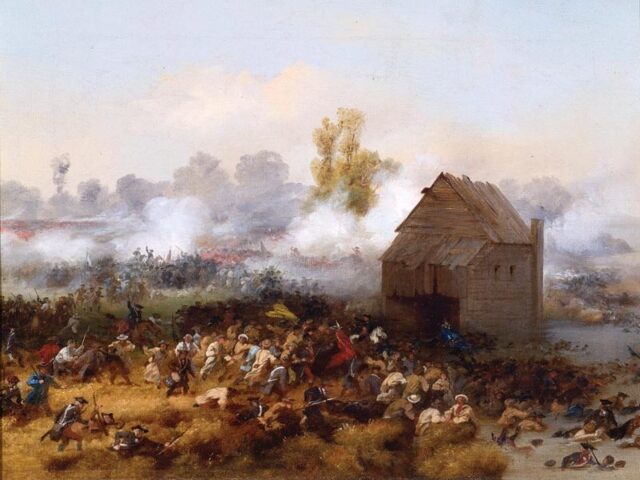Two hundred and forty-six years ago, this week, a few hundred Maryland soldiers bravely charged thousands of British soldiers and Hessian mercenaries to allow their brothers-in-arms to escape total annihilation.
This elite unit of Marylanders, known as “Washington’s Immortals” or the “Bayonets of the Revolution” for their Thermopylae-like charge against a British stronghold, bought with their blood “an hour, more precious to American liberty than any other in its history.”
These “Gentlemen of Honour, Family, and Fortune[’s]” selfless sacrifice allowed General Washington, his top commanders, and much of the fledgling American army to retreat and to fight again another day at a point when the entire Revolution, begun only a little more than a month earlier, might have become a mere footnote in British history. Most of the men who made the charge would never return home to Maryland: most would die that day or die on British prison ships, little more than floating concentration camps in New York Harbor.
By late August 1776, thousands of British troops had mainly landed unopposed on Long Island, bringing their total force up to approximately twenty thousand. The savvy British generals Henry Clinton, James Grant, and William Howe conspiring to crack down upon the colonists, had their troops coiled like a snake preparing to attack. Around 2 a.m. on August 27th, the British attacked the unsuspecting colonists—first, General Grant on the right side of the American line while Hessians attacked their center. Both attacks, however, were a ruse to keep the Patriots engaged. The main body of the British forces had left the night before around 9 p.m., led by Generals Clinton and Howe, and were executing a long, sweeping flanking maneuver to pound the Americans from behind and prevent their escape.
Additional troops arrived to reinforce the American line, including the Maryland regiment led by Lord Stirling and Major Mordecai Gist. However, the colonists still believed that Grant’s men were the main thrust of the British assault and merely intended to prevent the Redcoats from marching further.
The Americans withstood the British onslaught from sunrise until late morning, when the British temporarily ceased fire. The Americans soon realized the horror of their predicament when they heard fire on their left and discovered their enemy in their rear. They were surrounded with no hope of reinforcement. Howe’s massive flanking maneuver had essentially cut the American army defending Long Island in half.
The cold-blooded Hessian mercenaries did not bother to waste their bullets on the Americans captured in the British advance, but instead surrounded the hapless American soldiers. “They did not fire a shot, but pressed steadily forward until they could employ their bayonets.” The only retreat available was across a marsh and millpond, and required an eighty-yard swim through the swift current of Gowanus Creek to reach the relative safety of the American defenses on Brooklyn Heights. Making matters worse, on one flank of the marsh stood a stone house where hundreds of British troops were positioned, along with one of Britain’s most vaunted commanders, Cornwallis. It appeared the Redcoats might snuff out the fledgling American army and, perhaps, the Revolution itself.
This remarkable story and dozens of others are told in the bestselling book The Indispensables: Marblehead’s Diverse Soldier-Mariners Who Shaped the Country, Formed the Navy, and Rowed Washington Across the Delaware. The book recently released in paperback is a Band of Brothers-style treatment of the regiment from Marblehead, Massachusetts, a unique largely unknown group of Americans who changed the course of history.
Instead of retreating, Lord Sterling ordered Major Gist and the Maryland Regiment to mount a pre-emptive intrepid charge on the British troops near the stone house. The unconventional maneuver by these lion-hearted men and their bold, brave commanders allowed the rest of the army to escape across Gowanus Creek via the gap in the British line held open by the Marylanders.
Forming the rear guard, the Marylanders “closed their ranks over the bodies of their dead comrades, and still turned their faces to the foe.” Over and over, they renewed their attack on Cornwallis’ position, giving the rest of the men time to escape. General George Washington watching the gallant display through his spyglass from a distant hill cried out, “Good God! What brave fellows I must this day lose!”
The Marylanders fought valiantly, fearlessly surging again and again into a rain of deadly lead. Ultimately, the British and Hessian forces, massively outnumbering the Marylanders, encircled and defeated the Americans. Only a few would escape death, including Major Mordecai Gist.
The Marylanders held off the British long enough to save a core of Washington’s troops and, arguably, the bulk of the nascent American army from destruction. The Marylanders’ desperate assaults allowed them to escape to the temporary safety of their entrenchments.
Their sacrifice also set up one of the most extraordinary retreats in American history—an “American Dunkirk”—where the indispensable men of Marblehead, Massachusetts, utilizing a motley assortment of small boats, incredibly brought 9,500 members of the Continental Army across the East River to safety in Manhattan, but not before a “miraculous” fog moved in and screened their movements from the eyes of the British army.
Remaining as one of the great mysteries of the Revolution, the location of the fallen “Gentlemen of Honour, Family and Fortune” of Washington Immortals tragically remains unmarked and unknown somewhere beneath the surface, perhaps under a garage or below a paved street, intermingled with what should be hallowed ground.
Patrick K. O’Donnell is a bestselling, critically acclaimed military historian and an expert on elite units. He is the author of twelve books, including The Indispensables, Washington’s Immortals, and The Unknowns. O’Donnell served as a combat historian in a Marine rifle platoon during the Battle of Fallujah and often speaks on espionage, special operations, and counterinsurgency. He has provided historical consulting for DreamWorks’ award-winning miniseries Band of Brothers and documentaries produced by the BBC, the History Channel, and Discovery. PatrickODonnell.com @combathistorian

COMMENTS
Please let us know if you're having issues with commenting.